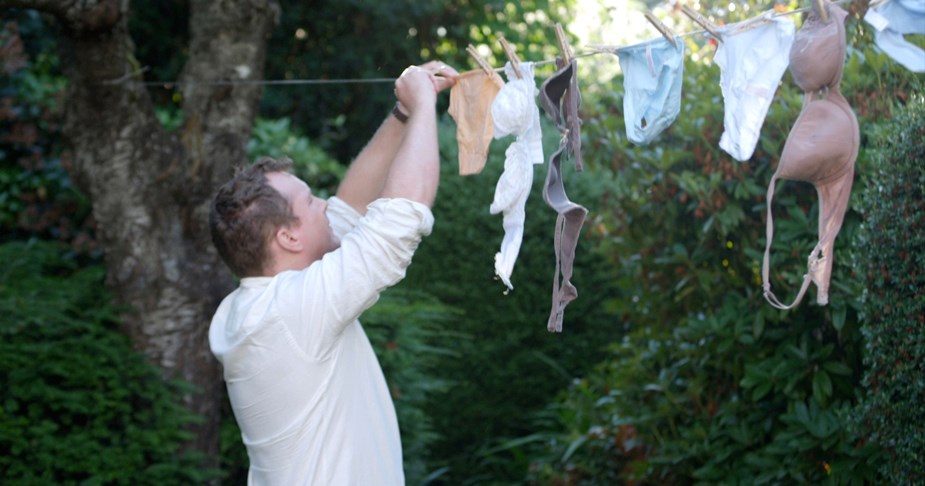In the film biz, “what if?” questions often lead to some wildly entertaining results – and filmmaker Mark Sawers began his latest project with a couple of doozies.
What if, in the 1950s, women started to be able to procreate spontaneously, without sperm? And what if these women only gave birth to girls?
As women begin to outnumber men, and the remaining males die off, what would happen to many facets of modern society: governments; religion; technology; war; the drudgeries of daily life that we take for granted?
And what would life look like for the last man ever born?
Sawers delves into these questions (and more) in No Men Beyond This Point.
The locally shot mockumentary premiered at the Toronto International Film Festival and will soon screen for the hometown crowd as part of the Vancouver International Film Festival.
There’s a grain of truth to his starting questions. Species do exist where females are able to reproduce asexually via a process called parthenogenesis, says Sawers, who also directed 2012’s Camera Shy.
Sawers first learned about parthenogenesis – otherwise known as “virgin births” – in an article he read years ago about female Komodo dragons laying viable eggs without insemination from their menfolk.
“I remember having this moment of angst, of connecting with this poor Komodo dragon that no longer has any purpose in life,” says Sawers in a recent phone chat.
“I think it’s been something that’s been lurking in my subconscious for a while, this notion of, ‘What is our purpose really beyond supplying sperm? Oh my god, are men necessary?’”
And so, to address these questions in feature-film format, Sawers adopted a two-pronged approach.
The first prong is a staple of documentary filmmaking: the classic journalistic style. No Men Beyond this Point features “interviews” with “experts” and “world leaders,” as well as a bounty of “archival material” (namely photographs and footage, the bulk of which – probably unsurprisingly, given the multitude of quotation marks in this paragraph – had to be created specifically for the film).
The other prong of No Men Beyond This Point is the “present-day” story of Andrew Myers (portrayed by Patrick Gilmore), who – at 37-years-old – is the youngest man alive.
Audiences see Andrew working as a housekeeper for an all-female West Vancouver family. Andrew wrestles with longing, copes with stares and varying degrees of pity and prejudice, and reflects on what it means to be the last of a gender on the brink of extinction.
Gilmore “has this everyman, Jimmy Stewart quality to him, and that’s what I wanted,” says Sawers. “He has a gentle quality that you would see why women would want him around.”
So, what exactly does an alternate present in which men are on the way out and women have been setting the course for decades look like?
The short answer is: It’s different, but not in a completely terrifying way (unless the concept of a world without iPhones scares you to the core).
Sawers started his exploration with the notion that men and women react to conflict in different ways.
Men react with a fight-or-flight instinct, and women react with tend-and-befriend, according to Sawers.
“So I took that controlling idea and said, ‘Okay, why would [women] have a military?’ And if you don’t have a military, you don’t have the technology that comes out of all of the military advancements, like the internet, which came out of defense spending,” says Sawers.
“You could make the argument that, without that defense spending, you might not probably have a digital world. Maybe eventually, but there wouldn’t be the need.”
As Sawers began to flesh out his fictional alternate reality, he started to feel like a bona-fide documentary filmmaker.
“You’re exploring stuff and you’re investigating and you’re talking to people and you’re getting information, and it’s shifting what you’re going to film as a documentarian,” says Sawers. “It took on this weirdly real approach, even though it’s a completely fake world, I still had to explore it.
Although the mockumentary makes some potentially controversial statements about what a women-driven world would look like (ie. Abrahamic religions are gone, and Paganism is all the rage; “You’re going to probably be a little bit more respectful of nature, considering that’s what’s causing you to reproduce”), Sawers says he hasn’t yet encountered anyone offended by his choices.
“People seem to just think it’s logical,” says Sawers. “Nobody’s been arguing with me about what I’m suggesting. I thought there might be a little bit more of, ‘Well, why do you think that’s going to happen? Why wouldn’t we discover the internet?’ But it just makes sense.”
No Men Beyond This Point features more than 125 local actors. Among them: Kristine Cofsky, Tara Pratt, Cameron McDonald, Rekha Sharma, Loretta Walsh, Jill Morrison, Enid-Raye Adams, Ben Cotton, and David Lewis.
The local factor makes the VIFF screening a rather special one for Sawers.
“With VIFF, it’s so great to screen the film for the community that you made the film in,” says Sawers. “This is just about pure joy of making a movie with your friends and your colleagues, and then being able to show it to your friends and colleagues. Just a child-like desire to put on a show: that’s how VIFF is for me.”
No Men Beyond This Points creens Oct. 2 as part of VIFF. For tickets and screening info, click here.


